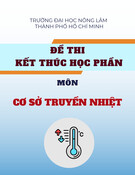
REGULAR ARTICLE
Thermal decomposition analysis of simulated high-level liquid
waste in cold-cap
Kota Kawai
*
, Tatsuya Fukuda, Yoshio Nakano, and Kenji Takeshita
Research Laboratory for Nuclear Reactor, Tokyo Institute of Technology, 2-12-1-N1-2, Ookayama, Meguro-ku, Tokyo 152-8550,
Japan
Received: 19 October 2015 / Received in final form: 30 September 2016 / Accepted: 8 November 2016
Abstract. The cold cap floating on top of the molten glass pool in liquid fed joule-heated ceramic melter plays an
important role for operation of the vitrification process. A series of such phenomena as evaporation, melting and
thermal decomposition of HLLW (high-level liquid waste) takes place within the cold-cap. An understanding of
the varied thermal decomposition behavior of various nitrates constituting HLLW is necessary to elucidate a
series of phenomena occurring within the cold-cap. In this study, reaction rates of the thermal decomposition
reaction of 13 kinds of nitrates, which are main constituents of simulated HLLW (sHLLW), were investigated
using thermogravimetrical instrument in a range of room temperature to 1000 °C. The reaction rates of the
thermal decompositions of 13 kinds of nitrates were depicted according to composition ratio (wt%) of each
nitrate in sHLLW. It was found that the thermal decomposition of sHLLW could be predicted by the reaction
rates and reaction temperatures of individual nitrates. The thermal decomposition of sHLLW with borosilicate
glass system was also investigated. The above mentioned results will be able to provide a useful knowledge for
understanding the phenomena occurring within the cold-cap.
1 Introduction
In the closed fuel cycles, high-level liquid waste (HLLW) is
generated from reprocessing of spent nuclear fuel. HLLW
possesses intrinsic characteristics such as decay heat,
corrosiveness and generation of hydrogen associated with
radiolysis [1,2]. Thus, long time storage of HLLW is
difficult in terms of confinement and management of
radioactive materials because of its liquid state. Therefore,
HLLW is immobilized into borosilicate glass matrix for safe
long-time storage. The immobilized HLLW is called
vitrified waste. Prior to the final disposal in deep geological
repository, vitrified waste should be cooled for 30–50 years
to achieve decrease of decay heat.
HLLW contains 31 kinds of nitrates which consist of
fission products, Na from alkaline rinse, P from TBP
degradation products, some insoluble particles such as Zr
fines from the cladding of the fuel elements, Mo and
platinum group metals (Pd, Ru and Rh) [3].
In the vitrification process, the cold cap floating on top
of the molten glass pool in liquid fed joule-heated ceramic
melter plays an important role for its operation. A series of
such phenomena as evaporation, melting and thermal
decomposition of HLLW takes place within the cold-cap.
The contact with glass beads results in further chemical
reactions to incorporate all waste constituents, either as
oxides of other compounds into the glass structure. The
cold-cap formation and conversion to glass take place
under non-isothermal conditions in a range of room
temperature to 1200 °C. It depends on the processing
parameters and properties of the various chemical elements
of HLLW. An understanding of the various thermal
decomposition behavior of many nitrates constituting
HLLW is necessary to elucidate a series of phenomena
occurring within the cold-cap. Some works such as
developments of simulation model in terms of heat balance,
kinetic analysis of reactions, decomposition of individual
chemicals used for the UK solution by means of thermal
balance and so on have been reported on the study of cold-
cap [4–9]. However, there are few studies which investigate
interaction among constituents of HLLW for cold-cap
reaction. In this study, we investigated thermal decompo-
sition of nitrates constituting HLLW at each temperature
region under an elevated temperature process by the mean
of reaction rate. In addition, the map of thermal
decomposition rate vs temperature for the nitrates
constituting sHLLW was depicted according to the
composition ratio of each nitrate that was contained in
sHLLW in a range of room temperature to 1000 °C in order
to simulate the thermal decomposition of sHLLW.
Moreover, we investigated effects of addition of borosilicate
* e-mail: kawai.k.af@m.titech.ac.jp
EPJ Nuclear Sci. Technol. 2, 44 (2016)
©K. Kawai et al., published by EDP Sciences, 2016
DOI: 10.1051/epjn/2016038
Nuclear
Sciences
& Technologies
Available online at:
http://www.epj-n.org
This is an Open Access article distributed under the terms of the Creative Commons Attribution License (http://creativecommons.org/licenses/by/4.0),
which permits unrestricted use, distribution, and reproduction in any medium, provided the original work is properly cited.

glass for the thermal decomposition behavior of nitrates
constituting HLLW in order to simulate practical phe-
nomena occurring in cold-cap. These results lead to further
clarification of transport phenomena and reactions occur-
ring over a range of room temperature to 1200 °C in cold-
cap.
2 Experimental
Table 1 shows the composition of sHLLW used in this
study. Composition of HLLW is determined by private
communication with Japan Nuclear Fuel Limited which is
Japanese reprocessing company based on the book
“Nuclear chemical engineering”written by Benedict et al.
[10]. The sHLLW was evaporated to dryness on a hot plate
at 70 °C in order to obtain the dried-sHLLW.
The thermal decomposition reaction of 13 kinds of
nitrates, which are main constituents of sHLLW (corre-
sponding approximately to 93.3 mol% of sHLLW), with
different chemical and physical properties were investigat-
ed using thermogravimetrical instrument (TG: TGA-50,
SHIMADZU). Table 2 shows 13 kinds of reagents. Ru was
omitted in this study due to cost, and Mo was also omitted
because thermal decomposition of sodium molybdate
dehydrate from room temperature to 1000 °C is only
dehydration which is occurring at around 100 °C. NaNO
2
was used as sodium nitrate for the following reasons.
Thermal decomposition of sodium nitrate under isothermal
conditions at around 600 °C is sequential reaction, which is
NaNO
3
→NaNO
2
→Na
2
O. The fractional reaction ais
defined as a=(m
ini
m
t
)/(m
ini
m
fin
); where m
ini
,m
fni
and m
t
are the weight at initial, final and a given time,
respectively. The avalue is 0.295 for NaNO
3
→NaNO
2
reaction step and 0.705 for NaNO
2
→Na
2
O reaction. The
thermal decomposition of sodium nitrate gradually starts
from 550 °C and the sequential reaction cannot be
confirmed under non-isothermal (1–10 °C/min) [11,12].
This suggests that NaNO
3
→NaNO
2
reaction proceeds
more rapidly than NaNO
2
→Na
2
O so that NaNO
2
→Na
2
O
reaction step is rate-limiting reaction. For this reason, as
the starting reagent, sodium nitrate (NaNO
3
) is replaced
by sodium nitrite (NaNO
2
).
The TG measurements were conducted with heating
rate of 5 °C/min in a range of room temperature to 1000 °C
at flow rate, 75 cm
3
/min of N
2
gas in order to evaluate the
thermal decomposition occurring under inert atmosphere.
The reaction rates of thermal decomposition of the nitrates
were calculated on the basis of the TG curves. The map of
their reaction rates and reaction temperatures was
described over their reaction temperature ranges under
heating rate of 5 °C/min. In addition, chemical compounds
were described in the map. Their compounds are estimated
stoichiometrically based on TG curves.
The thermal decomposition reaction of dried-sHLLW
and each nitrate included in the dried-sHLLW with
borosilicate glass powder were investigated as well. The
composition of used borosilicate glass is listed in Table 3,
which are determined by private communication with
Japan Nuclear Fuel Limited as well. The borosilicate glass
beads were ground to powder of 75 mm to 100 mmin
Table 1. Composition of simulated high-level liquid
waste.
Element Concentration
[mol/L]
Oxide concentration
[g/L]
H 1.38
Na 1.005 31.1
Nd 0.0615 10.3
Zr 0.0512 6.31
Gd 0.0364 6.6
Ce 0.0363 6.25
Cs 0.0358 5.04
Mo 0.0321 4.62
Fe 0.0307 2.45
La 0.0225 3.67
Ru 0.0219 2.91
Mn 0.0189 1.34
Ba 0.0161 2.47
Pr 0.0159 2.71
Pd 0.0155 1.9
Sr 0.0124 1.28
Sm 0.00898 1.57
Y 0.00815 0.92
Cr 0.0063 0.479
Rh 0.00501 0.636
P 0.0043 0.305
Te 0.00399 0.796
Ni 0.00109 0.814
Ag 0.000966 0.112
Others 0.00483 0.2978
Table 2. Used reagent for 13 kinds of elements (Wako:
Wako Pure Chemical Industries, Ltd., Kanto: Kanto
Chemical Co., Inc.).
Element Reagent Reagent-grade
Na NaNO
2
>98.5%, Kanto
Nd Nd(NO
3
)
3
·6H
2
O 99.5%, Wako
Zr ZrO(NO
3
)
2
·2H
2
O>97.0%, Wako
Gd Gd(NO
3
)
3
·6H
2
O 99.5%, Wako
Ce Ce(NO
3
)·6H
2
O>98.0%, Wako
Cs CsNO
3
99.9%, Wako
Fe Fe(NO
3
)
3
·9H
2
O>99.0%, Wako
La La(NO
3
)
3
·6H
2
O 99.9%, Wako
Mn Mn(NO
3
)
2
·6H
2
O>98.0%, Wako
Ba Ba(NO
3
)
2
99.9%, Wako
Pr Pr(NO
3
)
3
·6H
2
O 99.9%, Wako
Pd Pd(NO
3
)
2
>97.0%, Wako
Sr Sr(NO
3
)
2
>98.0%, Wako
2 K. Kawai et al.: EPJ Nuclear Sci. Technol. 2, 44 (2016)

diameter using an alumina mortar. The weight ratio of
dried-sHLLW or nitrate to the borosilicate glass mixture
was 40 wt%.
3 Results and discussion
3.1 Thermal decomposition behavior of constituents
of simulated HLLW
Figure 1 shows the reaction rate of thermal decomposition
of iron nitrate [Fe(NO
3
)
3
·9H
2
O]. It was dehydrated to
produce Fe(NO
3
)
3
. Then, it reacted to Fe
2
O
3
in the low
temperature range of 100 to 200 °C.
Figure 2 shows the reaction rate of thermal decomposi-
tion of zirconium nitrate [ZrO(NO
3
)
2
·2H
2
O]. It was
dehydrated to ZrO(NO
3
)
2
in the range of room tempera-
ture to 100 °C. ZrO(NO
3
)
2
was decomposed to Zr
2
O
3
(NO
3
)
and finally to ZrO
2
in the range of 100 to 400 °C.
Figure 3 shows the reaction rate of thermal decomposi-
tion of gadolinium nitrate [Gd(NO
3
)
3
·6H
2
O]. It was
dehydrated to Gd(NO
3
)
3
at around room temperature to
300 °C, Gd(NO
3
)
3
was decomposed to GdONO
3
at around
400 °C, finally to Gd
2
O
3
. Reaction step 1 (Gd(NO
3
)
3
→
GdONO
3
), step 2 (GdONO
3
→Gd
2
O
3
) proceeded sequen-
tially at around 400 °C (STEP 1), 500 °C to 600 °C (STEP
2), respectively.
Figure 4 shows the reaction rate of thermal decomposi-
tion of NaNO
2
. It was decomposed to Na
2
O in the region
above 600 °C. Furthermore, Na
2
O is sublimated above a
temperature of 800 °C. The thermal decomposition of other
9 kinds of nitrates were also investigated as well. The
results are summarized in Table 4. Iron nitrate was
decomposed in the temperature region lower than 200 °C.
The nitrates of lanthanoid series such as lanthanum,
neodymium and gadolinium nitrate were decomposed in
the middle range of 200 to 600 °C. Alkali metal and
alkaline-earth metal such as strontium, cesium, barium and
sodium were decomposed in the high temperature region of
600 to 1000 °C.
In Figure 5, the reaction rates of the thermal
decompositions of 13 nitrates were depicted according
to composition ratio (wt%) of each nitrate in a range of
room temperature to 1000 °C. The presence of Na is
dominant in sHLLW as shown in Table 1. The reaction
rate curves for 13 nitrates were superimposed on a graph
of reaction rates vs temperature, as shown by a red line in
Figure 6. The reaction rate curve observed from thermal
decomposition of dried-sHLLW (black line) was also
depicted in the same figure. As a result, the characteristic
peaks of thermal decomposition of dried-sHLLW were
fitted with overlapped reaction rates of thermal decom-
position of their nitrates, especially the peaks around
400 °Cand750°C corresponding to thermal decomposi-
tion of lanthanum nitrates and sodium nitrate. However,
Table 3. Composition of borosilicate glass.
Oxide composition Concentration ratio [wt%]
SiO
2
60
B
2
O
3
18.2
Al
2
O
3
6.4
Li
2
O 3.8
CaO 3.8
ZnO 3.8
Na
2
O 4.0
Fig. 1. TG curve and reaction rate of the thermal decomposition
of Fe(NO
3
)
3
·9H
2
O at heating rate of 5 °C/min.
Fig. 2. TG curve and reaction rate of the thermal decomposition
of ZrO(NO
3
)
2
·2H
2
O at heating rate of 5 °C/min.
STEP1
STEP2
Fig. 3. TG curve and reaction rate of the thermal decomposition
of Gd(NO
3
)
3
·6H
2
O at heating rate of 5 °C/min.
K. Kawai et al.: EPJ Nuclear Sci. Technol. 2, 44 (2016) 3

the disappearance of iron nitrate decomposition peak
and the appearance of peaks at 300 °C and 600 °C were
observed in Figure 6. It is assumed that iron nitrate is
decomposed with other chemical substances and thermal
decomposition of alkali and alkaline-earth metal nitrates
was promoted with other chemical substances at 600 °C.
Especially, contribution of decomposition of sodium
nitrate would be dominant. Therefore, it was found that
the thermal decomposition of dried-sHLLW could be
predicted from the relation between the reaction rates and
reaction temperatures for their nitrates. Investigation of
disappearance and appearance of peaks is a challenge for
the future.
3.2 Thermal decomposition behavior of constituents/
borosilicate glass system
In the cold-cap floating on molten glass, HLLW and
borosilicate glass coexist. Studying their interaction is
necessary to understand a series of phenomena occurring
within the cold-cap. Then, the thermal decomposition of
Fig. 4. TG curve and reaction rate of the thermal decomposition
of NaNO
2
at heating rate of 5 °C/min. Fig. 5. Thermal decomposition rate of 13 kinds of nitrates at
heating rate of 5 °C/min, which were depicted according to
composition ratio of each nitrate in sHLLW.
Fig. 6. Comparison between the thermal decomposition rate of
sHLLW ( black line) and that overlapping thermal decomposition
rates of 13 kinds of nitrates included in sHLLW (red line).
Table 4. Map of reaction property vs. temperature.
100°C 150°C 200°C 250°C 300°C 350°C 400°C 450°C 500°C 550°C 600°C 650°C 700°C 750°C 800°C 850°C 900°C 950°C 1000°C
NaNO
2
Nd(NO
3
)
3
• 6H
2
ODecomposition
→NdO(NO
3
)
ZrO(NO
3
)
2
• 2H
2
ODehydrating
→ZrO(NO
3
)
2
Decomposition
→Zr
2
O
3
(NO
3
)
Decomposition
→ZrO
2
Gd(NO
3
)
3
• 6H
2
ODehydrating
Gd(NO
3
)
3
Decomposition
→GdO(NO
3
)
Ce(NO
3
)
3
• 6H
2
ODehydrating
Ce(NO
3
)
3
Decomposition
→Ce
2
O
3
CsNO
3
Melting
Fe(NO
3
)
3
• 9H
2
ODehydrating
Fe(NO
3
)
3
Decomposition
→Fe
2
O
3
La(NO
3
)
3
• 6H
2
ODehydrating
La(NO
3
)
3
Decomposition
→LaO(NO
3
)
Mn(NO
3
)
2
• 6H
2
ODecomposition
MnO(NO
3
)
Decomposition
→MnO
Ba(NO
3
)
2
Pr(NO
3
)
3
• 6H
2
ODehydrating
Pr(NO
3
)
3
Decomposition
→PrO(NO
3
)
Decomposition
→Pr
2
O
3
Pd(NO
3
)
2
Decomposition
→PdO
Sr(NO
3
)
2
Dehydrating→Mn(NO
3
)
2
Decomposition→BaO
Nitrate Phenomena and Temperature
Melting Decomposition→Na
2
O→Sublimation
Dehydrating→Nd(NO
3
)
3
Decomposition→Nd
2
O
3
Decomposition→Pd
Decomposition→SrO
Decomposition→Gd
2
O
3
Decomposition→Cs
2
O→Sublimation
Decomposition→La
2
O
3
4 K. Kawai et al.: EPJ Nuclear Sci. Technol. 2, 44 (2016)

13 nitrates coexisting with borosilicate glass powder (75 to
100 mm in diameter) was investigated by the same way as
that described in the former section.
Figure 7 shows the thermal decomposition rate of
NaNO
2
with borosilicate glass powder in a range of room
temperature to 800 °C. The weight ratio, the vertical axis in
the figure, means the ratio of weight of remaining NaNO
2
to
initial weight. Then, it was assumed that the weight of
borosilicate glass powder is constant during the reaction.
Thermal decomposition of NaNO
2
in the presence of
borosilicate glass powder took place at much lower tempera-
ture than that of the sodium nitrite itself (Fig. 4). Similar
phenomena were reported by Abe et al. [13]. From the view-
point of thermodynamics, the following chemical reactions
can occur in the presence of borosilicate glass. These
reactions indicate that the thermal decomposition of sodium
nitrite is promoted and occurring at low temperature.
STEP 1
2NaNO2¼Na2O2þ2NO ð1Þ
Na2O2þNaNO2¼Na2OþNaNO3ð2Þ
Na2OþB2O3¼Na2O⋅B2O3ð3Þ
STEP 2
3NaNO2¼NaNO3þNa2Oþ2NO ð4Þ
2NaNO2¼Na2O2þ2NO ð5Þ
Na2O2¼Na2Oþ1
2O2ð6Þ
Na2OþSiO2¼Na2O⋅SiO2ð7Þ
STEP 3
2NaNO3¼Na2O2þ2NO þO2ð8Þ
Na2O2¼Na2Oþ1
2O2ð9Þ
2NaNO3¼Na2Oþ2NO þ3
2O2ð10Þ
Na2OþSiO2¼Na2O⋅SiO2:ð11Þ
Moreover, Na
2
O may not be sublimated inthe presence of
borosilicate glass as shown in Figure 7. For other alkali metal
and alkaline-earth metal nitrates, the thermal decomposi-
tion of their nitrates also took place at lower temperatures
due to the presence of borosilicate glass powder.
Figure 8 shows the thermal decomposition rate of
gadolinium nitrate in the presence of borosilicate glass
powder. In this case, the behavior of its thermal
decomposition is similar to the case without borosilicate
glass described in Figure 3. Thus, the effects by the
addition of borosilicate glass were not observed. For other
lanthanides and iron nitrates, the effects of the addition of
borosilicate glass were not observed as well.
Figure 9 shows the thermal decompositions rates of 13
nitrates in the presence of borosilicate glass powder, which
were depicted according to composition ratio (wt%) of each
STEP1
STEP2
STEP3
Fig. 7. TG curve obtained by the thermal decomposition of
NaNO
2
in the presence of borosilicate glass powder at heating rate
of 5 °C/min (solid line) and the thermal decomposition rate
calculated from the differential of the TG curve (dashed line).
Fig. 8. TG curve obtained by the thermal decomposition of Gd
(NO
3
)
3
·6H
2
O in the presence of borosilicate glass powder at
heating rate of 5 °C/min (solid line) and the thermal decomposition
rate calculated from the differential of the TG curve (dashed line).
Fig. 9. Thermal decomposition rate of 13 kinds of nitrates in the
presence of borosilicate glass powder at heating rate of 5 °C/min,
which are depicted according to composition ratio of each nitrate
in sHLLW.
K. Kawai et al.: EPJ Nuclear Sci. Technol. 2, 44 (2016) 5









![Ngân hàng trắc nghiệm Kỹ thuật lạnh ứng dụng: Đề cương [chuẩn nhất]](https://cdn.tailieu.vn/images/document/thumbnail/2025/20251007/kimphuong1001/135x160/25391759827353.jpg)






